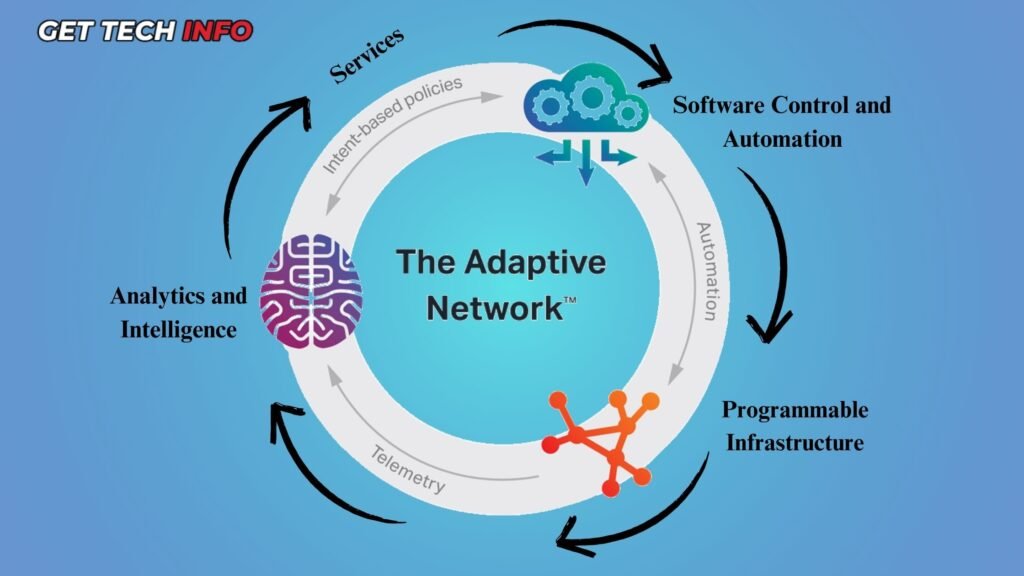These days, companies are working in a fast-changing digital world so they need networks that can keep up with the growing traffic and change as needed. That is where adaptive network control come in. It is a big change that adds smarts and flexibility to how we manage networks. Unlike old static networks, adaptive ones are made to grow, improve, and react to quick needs. This eventually helps companies stay ahead in the busy digital space. Let’s look into the main ideas, tech, and benefits that make adaptive network control technology a must-have for today’s businesses!
3 Core Principles of Adaptive Network Control
Adaptive network control is based on a few important core principles. Now these are that help it be more effective, smart, and quick to respond. Here are a few Core Principles of Adaptive Network Control.
- Real-Time Monitoring: Firstly, networks keep an eye on their performance to spot any problems ASAP.
- Dynamic Response: Furthermore, they can quickly adapt to changes like heavy traffic or fresh security threats, making sure everything runs without a hitch.
- Self-Optimization: Additionally, these adaptive network control rely on AI and ML to get better over time, picking up findings from prior encounters to become even smarter and more efficient.
What is The Technologies Behind Adaptive Network Control?
Now let’s check out some cool technologies that drive adaptive network control. These technologies help networks become more flexible, responsive, and smart.
- AI and Machine Learning (ML): These tools let networks learn from data and make smart choices, which helps with real-time optimization and solving problems.
- Cloud Computing and Virtualization: These options provide the needed framework to manage big, complex networks more flexibly, improving resource use and scalability.
- Internet of Things (IoT) and Edge Computing: These technologies handle data closer to where it’s created, which leads to faster response times and lower delays for key network tasks.
By using these state-of-the-art technologies, adaptive networks can, therefore, tackle the challenges of today’s digital world. By doing this, they can in fact upscale their performance and security.
Key Components of the Adaptive Network
A bunch of key parts or components help keep the adaptive network control running smoothly. To begin with, let’s dive into the main pieces that make it all work:

- Programmable Infrastructure: This covers both the physical parts (like routers, data centers, and switches) as well as virtual things that can be programmed to react to changes. For instance, if a network link starts lagging, the system can reroute data to keep things moving fast.
- Analytics and Intelligence: Next, adaptive networks scoop up a ton of data, which helps them make smart choices. Specifically, big data lets the network pick up on patterns and adapt over time, while small data helps in making quick decisions, like fixing a sudden drop in speed.
- Software Control and Automation: Furthermore, by taking care of routine tasks like tweaking routers or managing traffic, it helps cut down on human mistakes. Moreover, it keeps things running smoothly between different networks, no matter where they come from.
Thus all these parts work together to set up a solid base. Together they let the adaptive network function easily, with hardly any downtime and top-notch efficiency.
Benefits of Adaptive Network Control
The adaptive network brings a ton of perks that make it a great addition for businesses. Check out the list of the main benefits of Adaptive Network Control:
- Increased Efficiency: Firstly, self-optimizing networks make everything run smoother by adjusting to changes without needing someone to fix things manually.
- Enhanced Security: Secondly, with constant monitoring and quick reactions to threats, adaptive networks are way more secure.
- Cost Savings: Moreover, automating regular network management tasks allows businesses to save on operational costs and labor. The money thus saved can then be put towards more important projects.
Real-World Use Cases for Adaptive Networks
Adaptive networks are super flexible and have loads of practical uses across different industries. Here are some real-life examples where adaptive networks really shine:
- Traffic Management: Firstly, in fields like telecom, adaptive networks handle data flow way better, making sure that even during busy times, everything runs smoothly and quickly.
- Security Services: Additionally, banks and financial institutions use AI-powered adaptive networks to keep an eye on potential security threats in real time, which helps lower the chances of cyberattacks.
- Network Recovery: Moreover, in big companies, adaptive networks automatically reroute data if there’s a link failure, cutting down on downtime and keeping business running.
- Quality of Service (QoS): Furthermore, adaptive networks tweak resources according to how much users need, making sure that important applications, like video calls, always get the bandwidth they require.
Some Technological Changes Influencing Adaptive Network Control
As tech keeps getting better, adaptive networks are developing too. Here are some key trends that will influence how we control these networks in the future:
- 5G and Edge Computing: The rollout of 5G brings crazy-fast internet and super reliable connections. This allows adaptive networks to react quickly to changes, making your online time smoother and more efficient.
- Blockchain Technology: Keeping your data safe matters, and blockchain tech is here to help. It simplifies tracking data and lowers the risk of unauthorized access. So, you can trust that your data is secure while it moves through the network.
- Flexible Distribution Systems: Going forward with more renewable energy sources and electric vehicles, these networks need to be smart enough to handle shifts and keep things stable. This flexibility helps the network stay solid, even when stuff doesn’t go as planned.
- Advanced Communication Technologies: Good communication is critical for managing adaptive networks. Better technology will let data get sent quickly and securely, making it possible to monitor and adjust instantly. This means the network can tackle issues right away, keeping everything running smoothly.
By staying on top of these trends, businesses and individuals can step up their game and get ready for future challenges.
Wrapping Up
In a nutshell, adaptive networks are changing the game for how we connect with each other. These systems automatically tweak, optimize, and boost their performance on the fly. As companies navigate more complicated digital environments, jumping on board with an adaptive network strategy could totally give you an edge over your rivals. Ready to explore how this advanced tech can shake up your operations? Start by checking out what your current network needs are and looking into scalable adaptive solutions that fit your organization.
FAQs:
- What’s the difference between traditional and adaptive networks?
Traditional networks often remain static and require manual adjustments. However, adaptive networks can adjust automatically in real-time using AI and automation.
- How does AI step up network security in adaptive networks?
AI spots weird activity and jumps into action right away, stopping possible security issues before they blow up.
- Which industries get the most out of adaptive networks?
Industries like finance, telecommunications, and healthcare really cash in on adaptive networks.







